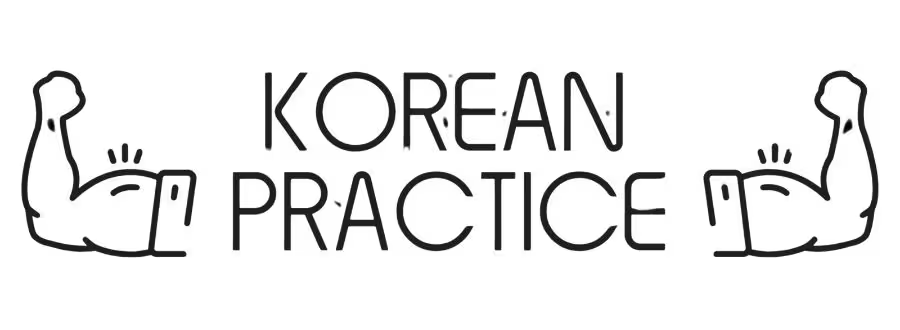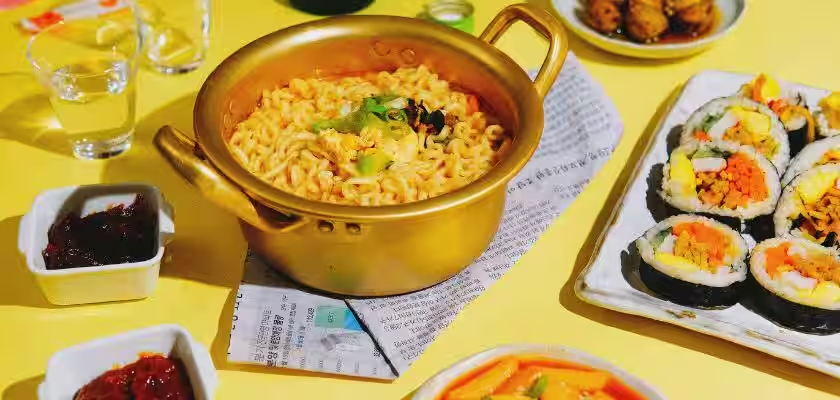Table of Contents
Whether you’re diving into K-dramas, traveling to Korea, or simply falling in love with the bold and unique flavors of Korean cuisine, learning how to say food in Korean is a great way to connect more deeply with the culture.
In this guide, we’ll explore the names of top Korean dishes, helping you expand your vocabulary with easy examples.
Why Learn Korean Food in Korean?
Korean cuisine is rich, flavorful, and rooted in centuries of tradition. But beyond just eating, learning food in Korean enhances your dining experiences. Whether you’re ordering bibimbap in Seoul or reading a Korean food blog, knowing the food in Korean makes everything more enjoyable—and respectful!
Popular Korean Food Names
- Here are some popular Korean food names with pictures in Korean that you’ll often see on menus and in daily life:
김치 (Kimchi) 🥘
- Kimchi is one of the most famous Korean food names. It’s made from fermented vegetables—usually napa cabbage or radish—seasoned with chili pepper, garlic, and ginger.
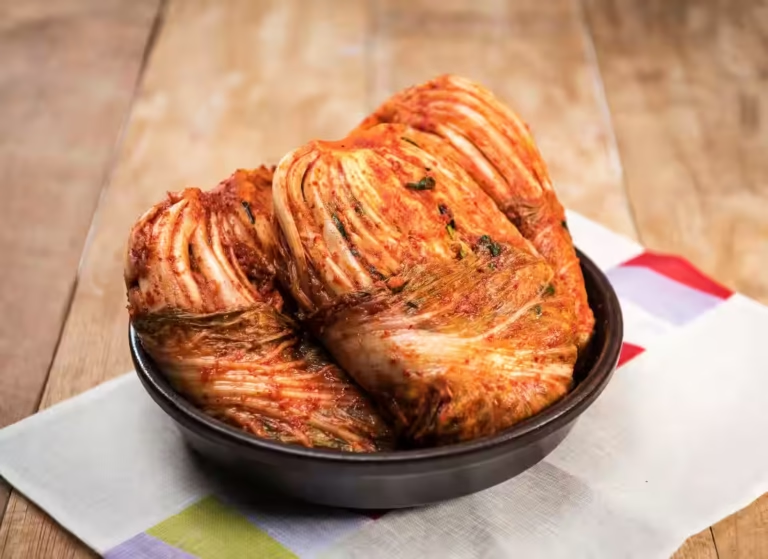
Example
Original Korean Sentence
김치는 정말 매워요.
Pronunciation Guide
김치는 (gim-chi-neun) 정말 (jeong-mal) 매워요 (mae-wo-yo).
Meaning and Context
김치 (kimchi) 는 (topic marker; as for kimchi) 정말 (really) 맵 (spicy) 어요 (is; I’m telling you polite and friendly).
Pronunciation Patterns for Conjugations
⊳ 맵 + 어요 = 매워요. Rapidly pronouncing ‘맵’ and ‘어’ results in ‘매워’ irregulary.
English Translation
Kimchi is really spicy.
Literal Translation
As for Kimchi – really spicy – is.

Want to learn Korean in a simple and structured way, just like this? My courses break down grammar step by step, making Korean easy to understand. Plus, you can try free sample lessons. Ready to start?
불고기 (Bulgogi)
- Marinated grilled beef, slightly sweet and savory.
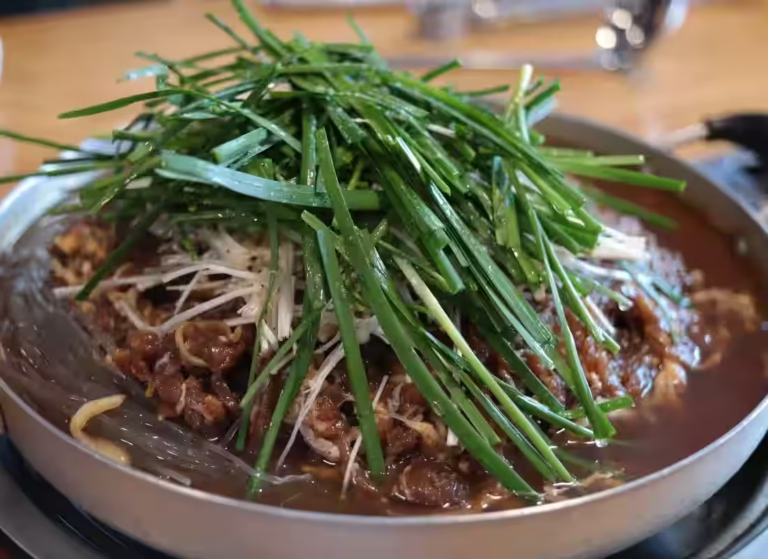
Example
Original Korean Sentence
불고기를 처음 먹어봤어요.
Pronunciation Guide
불고기를 (bul-go-gi-reul) 처음 (cheo-eum) 머거봣써요 (meo-geo-bwat-sseo-yo).
Meaning and Context
불고기 (bulgogi) 를 (my object is bulgogi) 처음 (first time) 먹 (to eat) 어보 (to try) 았 (past tense) 어요 (I’m tellling you polite and friendly).
Pronunciation Patterns for Conjugations
⊳ 보 + 았 = 봤. Rapidly pronouncing ‘보’ and ‘았’ results in ‘봤’.
Grammar
* 아/어 보다: When added to a verb, it means “to try doing (something).”
English Translation
I tried bulgogi for the first time.
Literal Translation
Bulgogi – first time – tried eating.
비빔밥 (Bibimbap)
- Bibimbap is a popular food in Korean cuisine. It’s mixed rice topped with assorted vegetables, gochujang (chili paste), and often a fried egg.
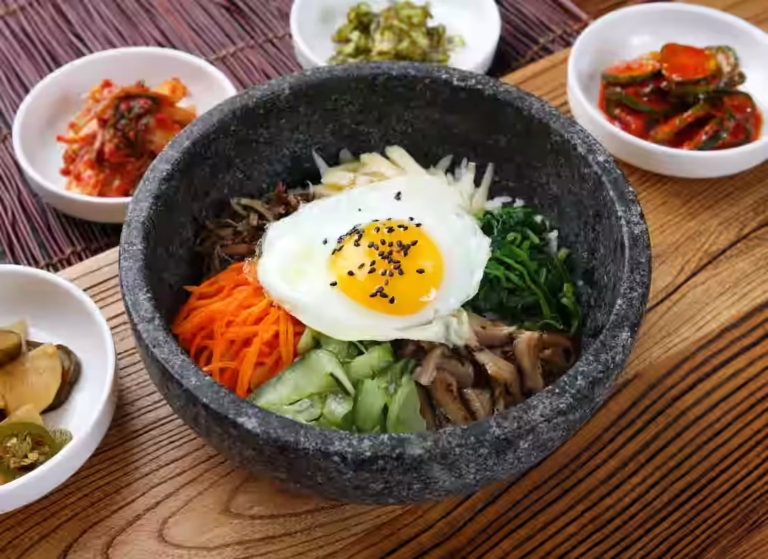
Example
Original Korean Sentence
저는 비빔밥을 자주 먹어요.
Pronunciation Guide
저는 (jeo-neun) 비빔빠블 (bi-bim-bba-beul) 자주 (ja-ju) 머거요 (meo-geo-yo).
Meaning and Context
저 (I) 는 (topic marker; as for me) 비빔밥 (bibimbap) 을 (object marker) 자주 (often) 먹 (eat) 어요 (I’m telling you polite and friendly).
English Translation
I often eat bibimbap.
Literal Translation
As for me – bibimbap – often – eat.
떡볶이 (Tteokbokki) 🌶️
- Spicy rice cakes in a sweet and fiery sauce.
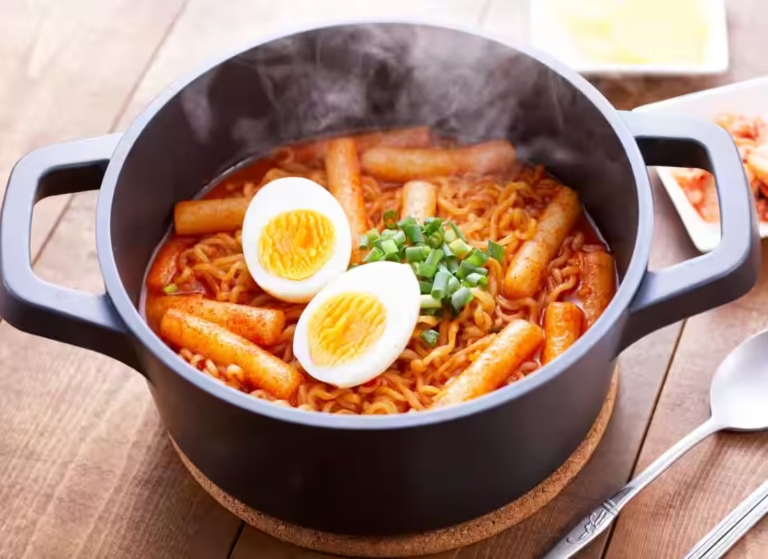
Example
Original Korean Sentence
떡볶이는 매콤하고 달콤해요.
Pronunciation Guide
떡뽀끼는 (tteok-bbo-kki-neun) 매콤하고 (mae-kom-ha-go) 달콤해요 (dal-kom-hae-yo).
Meaning and Context
떡볶이 (tteokbokki) 는 (topic marker; as for tteokbokki) 매콤하 (to be spicy) 고 (and) 달콤하 (to be sweet) 해요 (I’m telling you polite and friendly).
Pronunciation Patterns for Conjugations
⊳ 하 changes to 해
English Translation
Tteokbokki is spicy and sweet.
Literal Translation
As for tteokbokki – spicy and – sweet – is.
삼겹살 (Samgyeopsal) 🥓
- Samgyeopsal is a well-loved food in Korean cuisine—grilled pork belly enjoyed at BBQ restaurants.
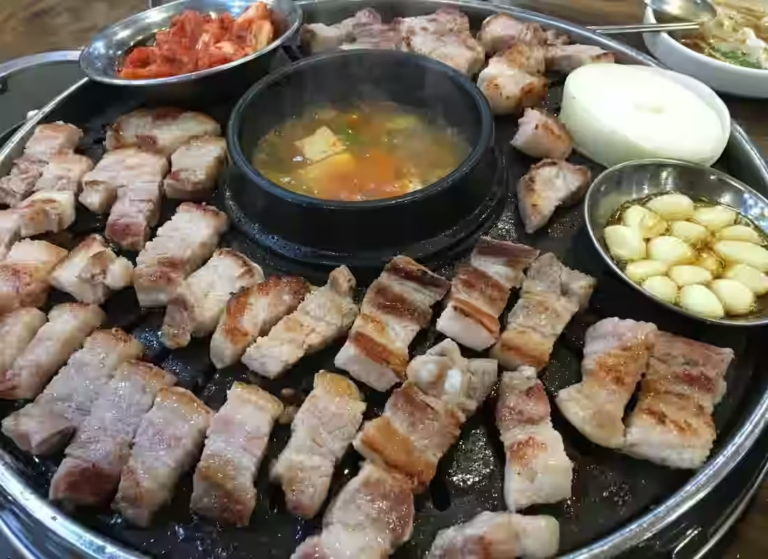
Example
Original Korean Sentence
저는 삼겹살을 구워 먹는 걸 좋아해요.
Pronunciation Guide
저는 (jeo-neun) 삼겹싸를 (sam-gyeop-ssa-reul) 구워 (gu-wo) 멍는 (meong-neun) 걸 (geol) 조아해요 (jo-a-hae-yo).
Meaning and Context
저 (I) 는 (topic marker; as for me) 삼겹살 (samgyeopsal) 을 (object marker) 구워 먹 (to grill and eat) 는 걸 (thing; “the act of doing” something) 좋아하 (to like) 해요 (I’m telling you polite and friendly).
Pronunciation Patterns for Conjugations
⊳ 굽 + 어 = 구워
When rapidly pronounced, ‘굽’ and ‘어’ naturally combine to form ‘구워’ irregulary.
Grammar
* 걸: Shortened from “것을,”
English Translation
I like grilling and eating samgyeopsal.
Literal Translation
As for me – samgyeopsal – grilling and eating – the thing – like.
된장찌개 (Doenjang-jjigae)
- Soybean paste stew with tofu and vegetables.
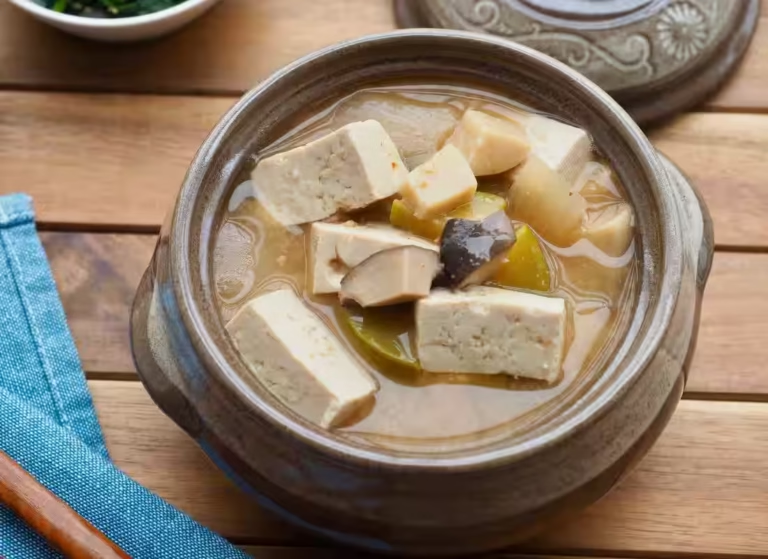
Example
Original Korean Sentence
된장찌개에는 두부와 채소가 들어 있어요.
Pronunciation Guide
된장찌개에는 (doen-jang-jji-gae-e-neun) 두부와 (du-bu-wa) 채소가 (chae-so-ga) 드러 잇써요 (deu-reo it-sseo-yo).
Meaning and Context
된장찌개 (doenjang stew) 에는 (in) 두부 (tofu) 와 (and) 채소 (vegetables) 가 (subject marker) 들어 있어요 (are inside; I’m telling you polite and friendly).
Pronunciation Patterns for Conjugations
⊳ 크 + 어 = 커
When rapidly pronounced, ‘크’ and ‘어’ naturally combine to form ‘커’.
Grammar
* 에는: “In” or “inside” with a topic marker.
* 들어 있다: Means “to be inside/contained.”
English Translation
Doenjang-jjigae has tofu and vegetables in it.
Literal Translation
As for doenjang stew – inside – tofu and vegetables – are in.
냉면 (Naengmyeon) 🧊
- Cold buckwheat noodles, perfect for summer.
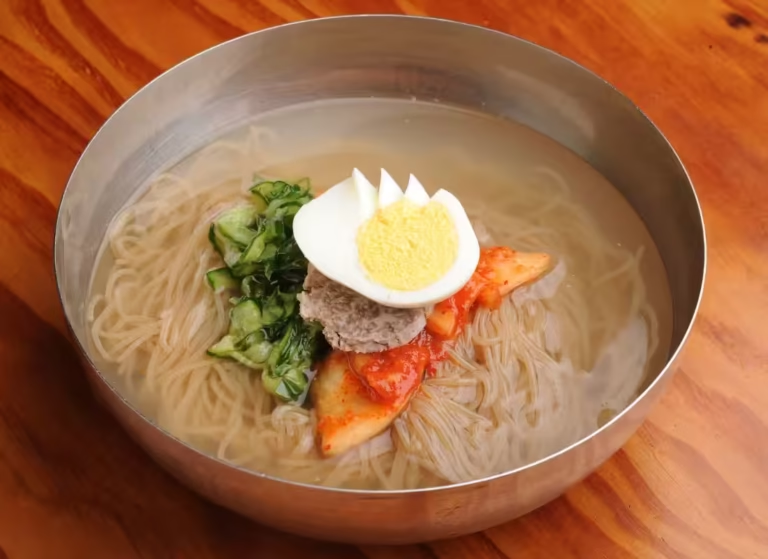
Example
Original Korean Sentence
여름에는 냉면이 최고예요.
Pronunciation Guide
여르메는 (yeo-reu-me-neun) 냉며니 (naeng-myeo-ni) 최고예요 (choe-go-ye-yo).
Meaning and Context
여름 (summer) 에는 (during/in) 냉면 (naengmyeon) 이 (subject marker) 최고 (the best) 예요 (is; I’m telling you polite and friendly).
English Translation
Naengmyeon is the best in summer.
Literal Translation
As for in summer – naengmyeon – the best – is.
갈비 (Galbi)
- Marinated short ribs, grilled or braised.
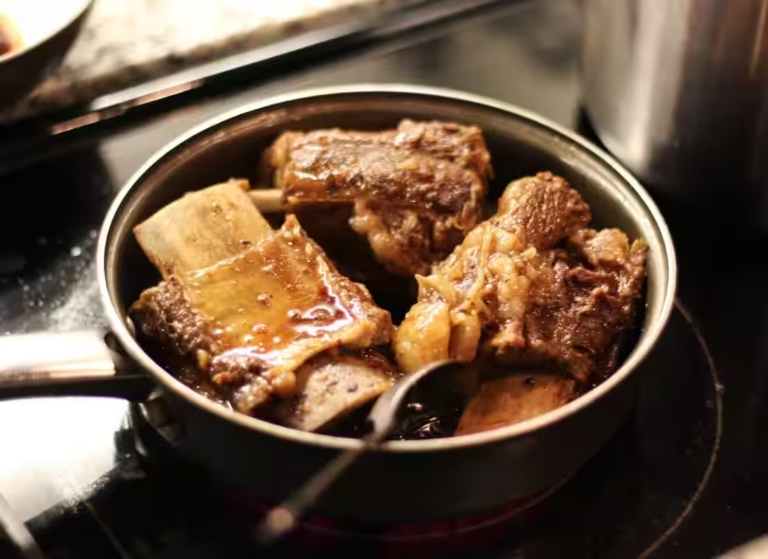
Example
Original Korean Sentence
갈비는 양념이 정말 맛있어요.
Pronunciation Guide
갈비는 (gal-bi-neun) 양녀미 (yang-nyeo-mi) 정말 (jeong-mal) 마싯써요 (ma-sit-sseo-yo).
Meaning and Context
갈비 (galbi) 는 (topic) 양념 (marinade/seasoning) 이 (subject) 정말 (really) 맛있 (to be delicious) 어요 (is; I’m telling you polite and friendly).
English Translation
The seasoning on galbi is really delicious.
Literal Translation
As for galbi – seasoning – really – delicious – is.
라면 (Ramyun) 🍜
- Ramyun is a spicy and savory food in Korean cooking—instant noodles served in a hot, flavorful broth.
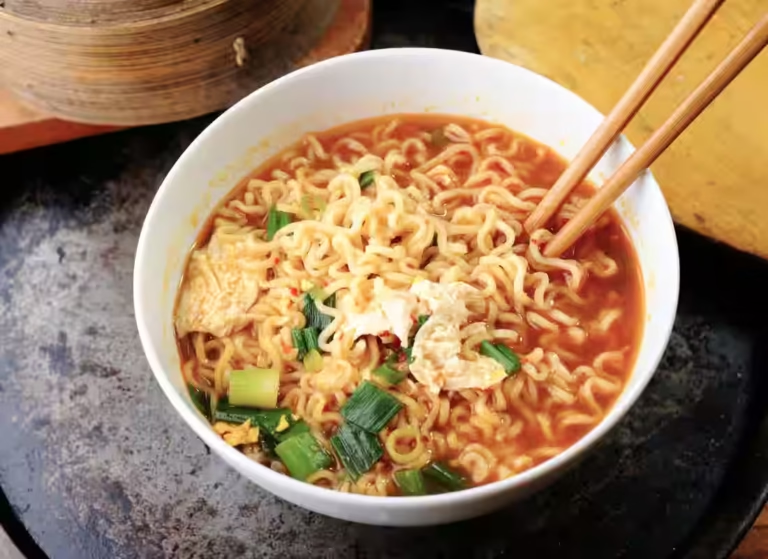
Example
Original Korean Sentence
혼자 있을 때 라면을 자주 끓여요.
Pronunciation Guide
혼자 (hon-ja) 잇쓸 (it-sseul) 때 (ttae) 라며늘 (ra-myeo-neul) 자주 (ja-ju) 끄려요 (kkeu-ryeo-yo).
Meaning and Context
혼자 (alone) 있 (~being) 을 때 (when) 라면 (ramyun) 을 (object) 자주 (often) 끓이 (to cook/boil) 어요 (I’m telling you polite and friendly).
Pronunciation Patterns for Conjugations
⊳ 끓이 + 어요 = 끓여요
When rapidly pronounced, ‘이’ and ‘어’ naturally combine to form ‘여’.
English Translation
I often cook ramyun when I’m alone.
Literal Translation
When being alone – ramyun – (I) – often – cook.
- Each dish brings its own regional flavor and cultural significance. They’re not just meals—they’re storytelling on a plate.
Cultural Tips for Dining in Korea
If you’re exploring food in Korean culture, it’s just as important to understand the etiquette as it is to know the dishes. Dining in Korea is not only about enjoying delicious Korean food names like kimchi, bulgogi, or tteokbokki, but also about showing respect and participating in traditions. Here are a few essential cultural tips to keep in mind:
🧓 Wait for the eldest to begin eating
In Korean culture, age and hierarchy are important, especially during meals. It’s considered polite to wait until the oldest person at the table picks up their chopsticks or takes the first bite. This is a small but meaningful way to show respect during dining in Korea.
Use two hands when pouring or receiving drinks
Whether you’re drinking soju or sharing a celebratory toast, always use two hands when pouring or receiving a drink. This shows courtesy, especially when interacting with elders or colleagues. You’ll often see this in scenes involving famous Korean food names and traditional gatherings.
🍚 Don’t stick chopsticks upright in your rice
Never place your chopsticks standing upright in a bowl of rice. This resembles a ritual performed at funerals and is considered extremely bad manners. If you’re learning about food in Korean settings, this is a cultural nuance that’s very important to remember.
🍽️ Sharing is the norm
Unlike in many Western cultures where meals are individually plated, Korean meals are meant to be shared. Dishes are placed in the center of the table—like kimchi, japchae, or doenjang-jjigae—and everyone uses their chopsticks to eat directly from the communal plates. This custom not only makes meals feel more communal but also lets you try a variety of popular Korean food names at once.
Learn food names with pictures
If you’re unfamiliar with the language, one fun way to get started is by learning Korean food names with pictures. This makes it easier to recognize dishes in restaurants and understand what you’re about to enjoy.
FAQs
What is “food” in Korean?
– The general word for food is 음식 (eumsik).
How do you say “I’m hungry” in Korean?
– You say 배고파요 (baegopayo).
What is the most famous Korean food?
– Kimchi is arguably the most iconic dish in Korean cuisine.
Are Korean dishes usually spicy?
– Many are, especially those with gochujang or gochugaru (chili flakes), but not all.
Can I find vegetarian options in Korean cuisine?
– Yes! Dishes like bibimbap or vegetable jeon (pancakes) are common.
How do Koreans usually eat rice?
– Rice is a staple and is usually served in a bowl alongside several side dishes (banchan).
Conclusion: Mastering Food in Korean
Learning food in Korean opens up more than just vocabulary—it introduces you to a whole new cultural experience. From the fiery heat of kimchi to the soothing warmth of soybean stew, every dish tells a story. Whether you’re planning to visit Korea or just want to enjoy your K-food at home, knowing the names in Korean makes every bite more meaningful.
Sign up for my newsletter and get
📖 Korean short stories
🎧 Listening practice with audio
❓ Vocabulary and grammar quizzes
🎁 Free courses
📝 Blog updates
– all delivered straight to your inbox!

